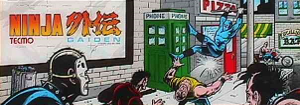Notmyhandle (talk | contribs) (Level up!) |
(A bit of updating and alteration) |
||
| Line 2: | Line 2: | ||
{{Infobox | {{Infobox | ||
|title=Ninja Gaiden | |title=Ninja Gaiden | ||
|image=Ninja Gaiden flyer.jpg | |image=Ninja Gaiden jp flyer.jpg | ||
|developer=[[Tecmo]] | |developer=[[Tecmo]] | ||
|publisher=[[Tecmo]], [[Sega]], [[Ocean]] | |publisher=[[Tecmo]], [[Sega]], [[Ocean]] | ||
| Line 16: | Line 16: | ||
{{marquee|Ninja Gaiden marquee.png}} | {{marquee|Ninja Gaiden marquee.png}} | ||
'''Ninja Gaiden''', later released in Japan as {{nihongo|'''Ninja Ryūkenden'''|忍者龍剣伝||lit. "Ninja Dragon Sword Legend"}} and in Europe as '''Shadow Warriors''', is a side-scrolling [[beat 'em up]] originally released by [[Tecmo]] as an [[arcade]] game. It was first released in North America, and Europe in [[1988]] and in Japan in [[1989]]. The ''Ninja Gaiden'' arcade game was produced and released almost simultaneously with its [[Ninja Gaiden (NES)|home console counterpart]] for the [[NES]], although they are different games with only a few similarities. | |||
It | The player controls a ninja whose mission to defeat an evil cult led by Bladedamus, a descendant of Nostradamus who seeks to fulfill his end of the world prophecies. Upon starting the game, the player is greeted by the phrase "NINJA IN USA". Up to two players can play simultaneously (Player 1 controls the blue-suited ninja, while Player 2 controls an orange-suited ninja). | ||
The first five rounds (stages) are based on actual American cities such as Los Angeles, New York City, Las Vegas, the Grand Canyon, and a Transcontinental Railroad. The sixth and final stage set inside the main villain's hideout. The game features a morbid continue screen, where the player character is tied to a table thrashing his head violently while a giant circular saw is being lowered towards him and what appears to be a crowd of enemies is watching in excitement in the background. It is remembered as an extremely difficult arcade game. | |||
Home versions of the ''Ninja Gaiden'' arcade game were released in Europe under the ''Shadow Warriors'' title in [[1990]] by [[Ocean Software]] for the [[Amiga]], [[Atari ST]], [[Commodore 64]], [[ZX Spectrum]], and [[Amstrad CPC]] computer platforms, and in North America for [[DOS]] by [[Hi-Tech Expressions]]. An [[Atari Lynx]] version was also released. The arcade version of ''Ninja Gaiden'' is also included as a hidden bonus game in ''[[Ninja Gaiden Black]]'' for the [[Xbox]] in [[2005]]. The arcade game was published as a [[Virtual Console]] game for the [[Wii]] in 2009. | |||
{{Continue Nav}} | {{Continue Nav}} | ||
<gallery> | <gallery> | ||
File:Ninja Gaiden | File:Ninja Gaiden ARC title.png|American title screen | ||
File:NinjaGaiden_spectrumcover.jpg|ZX Spectrum cover | File:Ninja Gaiden flyer.jpg|American promotional flyer | ||
File:NinjaGaiden_spectrumcover.jpg|ZX Spectrum cover | |||
</gallery> | </gallery> | ||
Revision as of 01:13, 5 May 2015
- For the NES version, see Ninja Gaiden (NES). For the Xbox version and all newer revisions, see Ninja Gaiden (Xbox).
Ninja Gaiden, later released in Japan as Ninja Ryūkenden (忍者龍剣伝? lit. "Ninja Dragon Sword Legend") and in Europe as Shadow Warriors, is a side-scrolling beat 'em up originally released by Tecmo as an arcade game. It was first released in North America, and Europe in 1988 and in Japan in 1989. The Ninja Gaiden arcade game was produced and released almost simultaneously with its home console counterpart for the NES, although they are different games with only a few similarities.
The player controls a ninja whose mission to defeat an evil cult led by Bladedamus, a descendant of Nostradamus who seeks to fulfill his end of the world prophecies. Upon starting the game, the player is greeted by the phrase "NINJA IN USA". Up to two players can play simultaneously (Player 1 controls the blue-suited ninja, while Player 2 controls an orange-suited ninja).
The first five rounds (stages) are based on actual American cities such as Los Angeles, New York City, Las Vegas, the Grand Canyon, and a Transcontinental Railroad. The sixth and final stage set inside the main villain's hideout. The game features a morbid continue screen, where the player character is tied to a table thrashing his head violently while a giant circular saw is being lowered towards him and what appears to be a crowd of enemies is watching in excitement in the background. It is remembered as an extremely difficult arcade game.
Home versions of the Ninja Gaiden arcade game were released in Europe under the Shadow Warriors title in 1990 by Ocean Software for the Amiga, Atari ST, Commodore 64, ZX Spectrum, and Amstrad CPC computer platforms, and in North America for DOS by Hi-Tech Expressions. An Atari Lynx version was also released. The arcade version of Ninja Gaiden is also included as a hidden bonus game in Ninja Gaiden Black for the Xbox in 2005. The arcade game was published as a Virtual Console game for the Wii in 2009.
-
American title screen
-
American promotional flyer
-
ZX Spectrum cover



